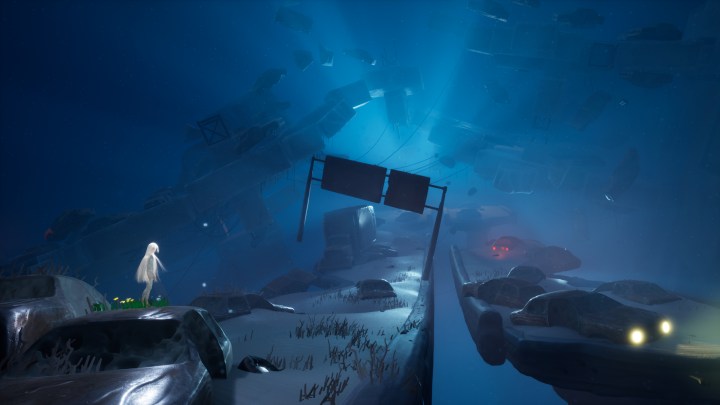There’s a sub-genre of games out there that I like to call the “atmospheric indie.” It’s a style of independent game in the style of titles like Limbo, which tends to lean on minimalistic platforming and eerie imagery. They’re pure tone pieces that tell their stories through environmental design and aren’t cluttered with complex gameplay systems. That makeshift genre is about to get another addition in the form of After Us.
First revealed at last year’s Game Awards, After Us is an unsettling postapocalyptic 3D platformer launching on May 23 for Xbox Series X/S, PS5, and PC. It follows a faerie-like character named Gaia who’s tasked with restoring life to a dark, surreal world when nature has been replaced by human wreckage. It’s both creepy in tone and somewhat hopeful, telling a story of hope as Gaia looks to bring grass and animals back to a twisted steel landscape.
Ahead of its launch later this month, I went hands-on with the first 90 minutes of After Us. For those who enjoy ambient games like Somerville, it’s shaping up to be a haunting cautionary tale about the ways tech and industry are sucking the life out of our planet. Just be prepared for a slow, meditative pace and drab art direction to drive home its point.
Restoring life
A quick opening cutscene sets up the story of After Us in a quick, efficient manner. Gaia watches as her woodland home suddenly has all its life sapped from it, with greenery and animals vanishing. From there, she’s tossed into an unsettling, nightmarish landscape made up of rusting metal and abandoned machines. The goal is to save the spirits of various animals lost in the sea of waste. The earliest level, for instance, has me jumping across stretches of decayed roads lined with hollowed-out cars in pursuit of a dog’s spirit.
I’m of two minds about the art direction and level design here, which goes heavy on monotone grays and assets that seem to repeat over and over. On one hand, it’s functional. Gaia’s world feels both oppressive and empty in the same breath, a mess of machines that feels like it’s suffocating the planet. On the other hand, it can make for some difficult navigation through cluttered gray landscapes. Even so, it does seem to get into more striking environments the deeper it goes. Some later levels would have me skating across a sea of telephone wires and navigating a mountain of TVs, bringing it more in line with peers like Little Nightmares 2.

After Us doesn’t go too heavy on complex gameplay mechanics at first, offering some simple platforming that makes it easy to soak in the imagery. I’m mostly chaining together jumps, hovers, dashes, and wall runs to navigate the twisted maze of decay. It almost calls Sonic Frontiers to mind, with an emphasis on fluid movement across a sea of disparate objects eerily floating in space (that connection especially comes up when I’m grinding across telephone wires). Platforming can feel imprecise, as I had more trouble than usual judging distance on my jumps, but the straightforward controls help alleviate some of that frustration.
Gaia’s journey gets a little more intriguing when After Us dives into puzzle-platformer territory. A late part of my session has me following colored wires to power up TV monitors. Once turned on, Gaia can teleport through a TV, which spits her out of another one in the environment that’s broadcasting the same image. One puzzle has me warping my way up a wall of TVs, falling from one monitor to the next until I reach the one at the top. Moments like that have me more intrigued to see where After Us goes as it gets more creative with the ways Gaia interacts with the discarded tech around her.

What’s a little less promising is its combat. Gaia can shoot out a little ball of blue energy, which is used to collect animal spirits, open gates, and attack enemies. The early battles I fought had my simply pulling the left trigger to shoot the ball at creepy humanoid enemies and recalling it to grab it again. Gaia can dodge attacks and escape an enemy’s grasp with a little button mashing, but that’s about the extent of it. The only time I need to do much more is when fighting an enemy with a massive TV protecting its belly, forcing me to dash behind it and shoot its back. I’m hoping that the system gets a touch more involved as it goes, or at least doesn’t play too big a role in the game.
Despite some slow moments in its opening hours, I’m interested to see where Gaia’s journey is headed as she rescues more spirits. My first 90 minutes are harrowing as I navigate a dreary industrial dystopia, but I already know redemption is possible. The more spirits Gaia rescues, the more spectral animals begin popping up throughout the levels. There’s hope hiding in the darkness, something that makes for a motivating story of environmental destruction.
After Us launches on May 23 for Xbox Series X/S, PS5, and PC.
Editors' Recommendations
- Don’t ask questions! Just play this wild and weird nun game
- Don’t miss this great sci-fi RPG while it’s free on the Epic Games Store
- Don’t worry, the Riven remake won’t feature any AI-assisted content
- Don’t buy the new MSI Claw handheld — at least not yet
- Don’t skip over our 5 favorite minigames in Final Fantasy VII Rebirth



